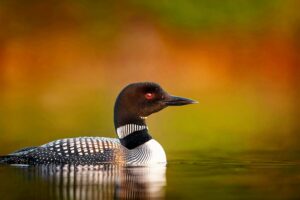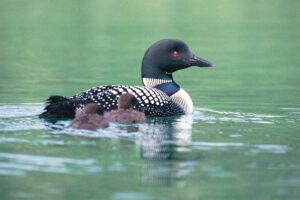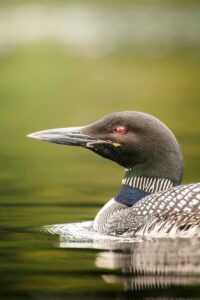The Common Loon (Gavia immer)

Cleon and I spent Christmas in Michigan and Wisconsin and as we were driving through the rural parts of both states past wetlands and lakes, I started thinking about Common Loons.
The population numbers of loons used to be greater. In the early to mid 1900’s, they nested throughout our northern states and the Midwest – including central Illinois where I live. Today, all of us in the continental U.S. might see a Common Loon in migration – if we are in the right place at the right time and are lucky. I checked two range maps: allaboutbirds.org from the Cornell Lab of Ornithology and The Sibley Guide to Birds, Second Edition by David Allen Sibley (2014) and the winter range differs quite a bit. Sibley’s book includes all our southern states as their winter range and allaboutbirds does not – that is a big difference. I have birded at Wheeler National Wildlife Refuge (Decatur, Alabama) but did not see any. However, that is only one place. If any of you reading this live in our southern states or bird in our southern states in winter and have seen Common Loons, please share with the rest of us where and when you saw them in the Public Forum.
Besides our southern states, we could see a Common Loon in winter along the Atlantic, Pacific, and Gulf Coasts. Cleon and I have birded many times in winter at Assateague National Seashore in Virginia, on the Outer Banks of North Carolina, and along the Gulf Coast of Florida near Apalachicola, but have only seen a loon or two (in the ocean off the Outer Banks near Rodanthe) – loons are a rare sighting for us. And these are birds I look for every time I set up the scope.
Their nesting range has been shrinking and is now much smaller than it was historically. This range in the continental U.S. is now only in the most northern areas of our northern states. There are conflicting numbers depending on the source, but it seems Minnesota has the most Common Loons of any state – an estimated 12,000 nesting pairs*. Fortunately for loons, there is still so much area in central and northern Canada that is not populated. No roads, and no cities, towns, or even houses. There is airborne pollution that affects the lakes, but not to the extent as our lakes in the U.S. are affected. Here, loons can nest and be totally undisturbed by people. In Canada, there are an estimated 200,000-250-000 pairs of nesting Common Loons – so still somewhat of a stronghold for them.
Loons are very skittish nesters. If they are disturbed or frightened, they often abandon their nests. And these disturbances include speed boats and fishermen who get too close. The wakes of boats at full throttle can swamp a nest, destroying the eggs. Wakes can also drown young loons who are out on the water with a parent. Many lakes where loons nest – or formerly nested – are also now filled with homes and vacationers with their boats and sometimes overwhelming presences. It is not that people set out to upset a nesting loon, but we are all curious by nature, and just want to get a bit closer to see. And that can be enough.
And the way loons are set up to live does not help them. For example, each pair of loons claims a fairly large nesting area. Ponds and small lakes that are from about 12-125 acres generally have only one pair of nesting loons. On larger lakes, one pair will claim a bay or inlet and will not allow other loons to nest in that area. These pairs do spread out.

Once the nest is built, the female most often lays only 1-2 eggs which means only 1 or 2 babies. And only one brood each year. Compare this to our American Robin who lays 3-5 eggs per nest and generally has 2 broods each year. Because loons do not nest close together and lay only 2 eggs a year, you can see why loons do not repopulate quickly and it is easy for their population numbers to plummet.
Loons also have water quality requirements. They eat fish which they catch under water – by sight. So water has to be clear. They are also susceptible to lead and mercury which poisons them and is always fatal within about 2-4 weeks. All birds are susceptible to poisoning by both, but loons are more likely to be poisoned. Loons swim to the bottom of lakes and ponds to ingest small pebbles which they need to digest food. Birds do not have stomachs – they have gizzards. Instead of dissolving food with stomach acids as we do, their gizzards use muscular contractions to grind food up and the pebbles loons ingest help with that. Unfortunately, loons cannot distinguish small pieces of lead from pebbles and will ingest them. A loon that ingests even one piece of lead will die – and probably within a month. And it is an agonizing death filled with disorientation.
Loons spend almost all their time on water. Unfortunately, most of our lakes and wetlands contain mercury and lead. They eat fish which they catch by diving underwater – and these fish can also contain mercury and lead which when eaten, is then in the loon and stays there. Their legs are set back farther on their bodies than ducks and geese. And in proportion to their bodies, they have big feet. Their legs and feet work as quite efficient propellers making them fast and agile underwater swimmers – excellent predators of fish. But while these legs and feet are perfect for underwater swimming, they are just awful for walking. The legs are too far back and they have trouble picking up their very large feet, so on land, this bird is clumsy and walking takes a great deal of effort. They cannot stand upright like a penguin, so walk with their bellies dragging on the ground and their legs using more of a pushing motion to propel them forward. Awkward, ungainly, and difficult. So you will rarely/never see a loon on land except to nest and even then the nests are on floating islands of branches and debris or right on the edge of the water.
Putting this together, you can see why the population of these loons has declined once people started building homes for residence or vacation which led to more and more boats at full-throttle, racing up and down lakes, plus at least for a time, more and more fishermen using lead sinkers and jigs**. Levels of mercury in freshwater lakes all over the world are rising. Mercury gets into lakes through rainfall. It is always part of our atmosphere, but the levels are rising. Mercury comes from volcanic eruptions and the natural erosion and breakdown of rocks and soil. And we humans are also responsible for rising mercury levels in the air: burning coal, wood, or natural gas; incinerating products which contain mercury such as paint, thermometers, and batteries; and through some industrial processes and mining.

It seems that loons are more sensitive to these changes than many other birds and animals. They are quicker to leave an area if they are disturbed or uneasy, and quicker to show signs of lead or mercury poisoning. The first has proved to be a way to help them.
Some states monitor loon populations in specific areas. If their numbers decrease, water quality is checked for lead and mercury. In this way, loons are being relied on as predictors of rising contamination. If loons are nesting and healthy in an area of lakes and wetlands, it can be assumed the water quality is acceptable. And by keeping these waters clean and clear, these states are giving loons a helping hand.
Although since 1900, it is estimated the population numbers of Common Loons have decreased by quite a lot, since their northern nesting lakes in the continental U.S. are being monitored, their population numbers while not increasing, now seem stable. Banning lead pellets everywhere and lead sinkers and jigs in many places has helped these loons.
If you would like to help, go online – there are dozens of programs in which you can volunteer or donate money. Here are a few – but there are more so take a look.
Volunteer Loon Watcher Survey
Gulf Chain of Lakes Association – Loon Program
Loon Watch in Vermont
Lookout for Loons – Maine
And last, I could not end this blog on one of my favorite water birds without explaining that loons are not ducks. They have been classified in a group all by themselves. Other water birds that also have separate groups are cormorants, grebes, and coots. Allaboutbirds.org puts all four together and calls them the “Not-Ducks” I like that!
*All five species of loon nest in Alaska, so if you add all five species of loons together, Alaska has the largest number of loons. But as they are estimated to only have about 5000 pairs of nesting Common Loons, Minnesota has more of that species.
**As of 1991, there has been a nation-wide ban against using lead pellets when duck and geese hunting. This ban helped stabilize the population numbers of all water birds – particularly the ones who dive and swim underwater. Some states have banned lead sinkers and jigs and some have not. Most of our northern states have a ban in place that prohibits selling them and using them. As of 2010, the Illinois state legislature also put a ban in place. However, I did some research and could not find any evidence that there is a ban in Minnesota. If any of you who are reading this live in Minnesota, please update all of us in the Public Forum on what you know about a ban on lead sinkers and jigs in your state.

